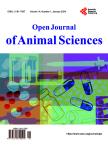Heat Production Partition in Sheep Fed above Maintenance from Indirect Calorimetry Data
Heat Production Partition in Sheep Fed above Maintenance from Indirect Calorimetry Data作者机构:Research Center ACUMA Animal Science Department Polytechnic University of Valencia Valencia Spain Interuniversity Institute of Bioengineering Research and Technology Oriented to the Human Being Universidad Politécnica de Valencia Valencia Spain
出 版 物:《Open Journal of Animal Sciences》 (动物科学期刊(英文))
年 卷 期:2015年第5卷第2期
页 面:86-98页
学科分类:1002[医学-临床医学] 100214[医学-肿瘤学] 10[医学]
主 题:Sheep Heat Production Partition
摘 要:The objective of this study is to compare the partition of heat energy (HE) in two sheep breeds by indirect calorimetry and integral calculus. An experiment was conducted with two Spanish native sheep breeds (dry and non-pregnant) which were fed with pelleted mixed diets above maintenance. Six Guirras and six Manchegas breed sheep were selected (58.8 ± 3.1 and 60.2 ± 3.2 kg body weight, respectively). All sheep were fed with the same concentrate mixed ration (0.300 kg cereal straw as forage and 0.700 kg concentrate) in two meals. Half the daily ration was offered at 800 h and another half at 1600 h. The sheep had free access to water. Sheep were allocated in metabolic cages;energy balance and gas exchange were assessed in each sheep. The statistical analyses included the fixed effect of breed and random effect of sheep. The metabolic energy (ME) for maintenance represented 69% of the total ME intake and the average was 354 kJ per kg of metabolic body weight (kg0.75 BW) on average. The basal metabolism (HeE) was greater (P 0.05) in Guirra than Manchega breed (270 ± 18 vs. 247 ± 15 kJ/kg0.75 BW and day). As sheep were fed with above maintenance, the retained energy in the body accounted for 22% of the ME intake and 77% of the ME intake was lost as heat. 51% of the MEI was converted to HeE;5% was lost as physical activity of standing and lying down (HjE), and 13% was associated with the process of feeding and work of digestion and metabolism (HdE). Within HdE, 47% represented the cost of intake and feeding and 54% the cost of digestion and metabolism. No differences in HE partition between breeds were found, although Guirra breed showed less efficiency of energy retention than Manchega breed. Therefore, this study demonstrated a tentative approach of partitioning HE, combining indirect calorimetry and integral calculus.



